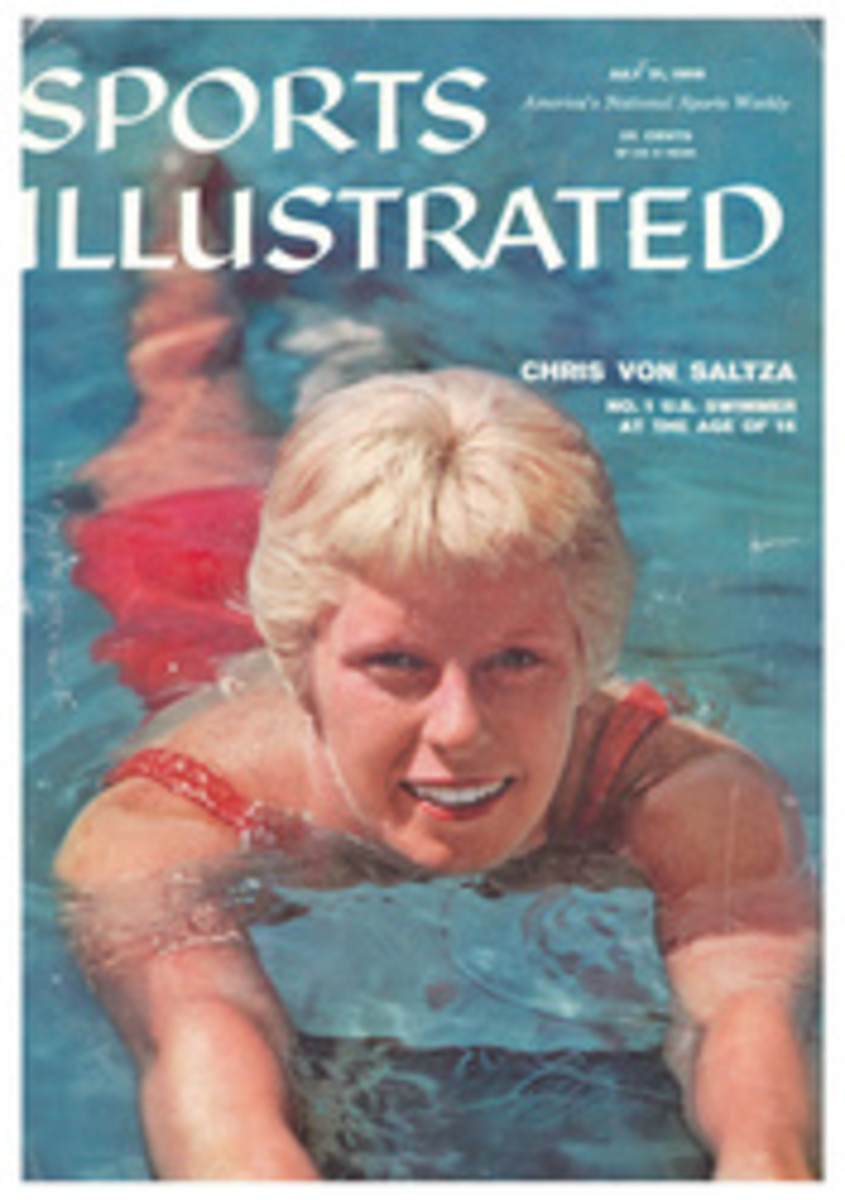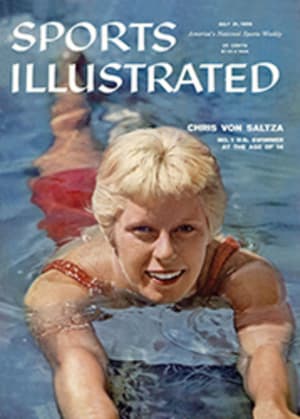
'I LIKE TO BEAT 'EM'
On July 4th, in a swimming meet at Fleishhacker Pool in San Francisco, a pretty blonde lass stepped to her marks. A friendly voice on the loudspeaker announced: "This is a special race. Chris von Saltza, swimming alone, will attempt to break the American record in the 100-meter freestyle. Good luck, Chris." Shivering from the cold, biting wind which blew in from the Pacific Ocean a few yards away, the 14-year-old girl turned to her young coach, George Haines, and said plaintively: "I have to break the record; it's been in all the papers. If I don't, I'll feel like a fool."
Seconds later the starter's gun barked. Chris von Saltza plunged into the icy salt water and stroked powerfully toward the temporary bulkhead 50 meters away. Her start was poor, her muscles stiff from the chilling wind. Chris made the turn in 30.9 seconds and headed for home. Halfway up the pool the announcer came on again: "Let's bring her in, folks." The 200 spectators chanted, "Come on, Chris"—32.7 agonizing seconds later she touched the pool's edge. Miss Von Saltza had swum, under something less than ideal conditions, the fastest 100 meters ever turned in by an American woman—1:03.6.
Forty minutes later, Chris was aroused from her sleeping bag near the pool for the 400-meter freestyle. As she shuffled sleepily and self-consciously by the stands her mother, in the front row, said quietly, "Wake up, Chris." Her daughter smiled and nodded.
At the end of 200 meters, nearly a lap ahead of her nearest opponent, Chris was obviously heading for another record. She finished strong and seemingly fresh in 4:59.2, the fastest 400 meters ever swum by an American girl. Young Von Saltza finished off the day by winning the 100-meter backstroke in 1:13.9, slightly more than a second over the world record, then anchored her Santa Clara Swim Club team to a 400-meter relay victory. Five days before, at the Olympic pool in Los Angeles, Chris had broken her own American record in the 200-meter freestyle. Time: 2:17.1. All in all, it was quite a week's work for a 14-year-old.
Chris von Saltza is the best freestyle swimmer ever developed in America. But if the Olympics were held today, on the basis of comparative times, Chris could not win either the 100- or 400-meter freestyle: Australians Dawn Fraser and Lorraine Crapp have swum better times respectively in these events and, if these two fade, the Aussies' massive, coordinated—in a sense subsidized—swimming program will certainly develop other girls of equal talent.
Eight years ago, a personable, good-looking Santa Clara High School coach named George Haines decided to organize an age group swimming team. A former collegiate swimmer from Kalamazoo College and San Jose State, Haines got approval from the school board to use the pool late in the afternoon and during specified hours on weekends. Working without pay, Haines set about collecting a group of swimmers—boys and girls—who would be willing to work hard. Five years after the Santa Clara Swim Club started, a San Jose radiologist named Dr. John von Saltza came to the pool with his two daughters, Karen, aged 13 and Chris, aged 11. Neither had swum competitively, but they came from an athletic family. John von Saltza's father, Phillip, made the second string All-America football team at Columbia in 1905. Husky, handsome John von Saltza had been on the Stanford swimming team. Of the two little girls, Chris was the stronger and the more athletic—she could throw a football farther and a baseball harder than anyone in the block, was quarterback on the neighborhood touch football team and pitcher on the baseball team.
SLEEPS AND SWIMS
Haines agreed to take on the two von Saltza girls, threw them in the pool with his other 60 squealing, enthusiastic boy and girl swimmers. Within two months, Haines knew he had an exceptionally talented swimmer in young Chris. Even with the crudest form, she showed power and speed in the freestyle. Chris had three other characteristics which impressed George Haines. She was extremely competitive ("I like to beat 'em"); she was calm, slept between races rather than waste energy worrying about competitors; she took instruction beautifully. The last was most important at the tiny Santa Clara High School pool. With so many kids Haines doesn't have time for individual instruction. He gets them all in the pool and yells. "The other kids were always laughing and fooling around. Whenever I spotted Chris she was watching me and listening to everything I said."
In her second year, at the age of 12, Chris qualified for the Olympic tryouts in Detroit. She missed by a heart-breaking few seconds in the 400 meters. Chris would have been the youngest girl ever to make the Olympic swimming team. Then and there Chris decided she was going to make the 1960 team.
Immediately after the Olympic Games, Haines and Chris went to work on a four-year program. Chris had no trouble with her legs: she was born with a powerful kick. The arms were the problem. Haines was impressed with the Aussie girls' high arm recovery and powerful stroke. He became convinced, after viewing pictures of Dawn Fraser and Lorraine Crapp, that the arms were all-important. "The kick is the stabilizer," says Haines, "a good swimmer must have powerful legs to keep the body planing. Then the arms can do the work." Chris started on intensive arm- and shoulder-building exercises out of the pool and began laboriously switching from the stiff, low-arm method of bringing the arms forward to the more efficient bending of the arms abruptly and throwing them close to the head. To simplify, it meant that when the left arm passed the head in the low, straight arm recovery it looked like a left turn signal; in the high arm recovery it was bent and pointed upward, like a cricket's hind leg.
Chris also learned to breathe without moving her head more than a fraction of an inch. Spectators invariably ask Haines: "When does she breathe?" If there is any difference, today, between her style and the Aussies' it would be Chris's relatively slight roll. She rides high on the water, her body is so well balanced you could, George Haines says, "ride a bucket of water on her back without spilling a drop." Ann Curtis, until Von Saltza the fastest freestyle swimmer ever developed in America, and a stylist herself, met Chris for the first time at the Fleishhacker Pool. Said Ann: "She swims like a dream. I got goose pimples just watching her." In Ann's opinion Chris's best distance is the 400 meters.
Chris now has the motivation and the form. Between now and the next Olympics her improvement will depend on conditioning. Knowing this, George Haines is putting her and a few others of his best young swimmers on a two-a-day workout schedule when school starts next fall. This means that, rain or shine, this 14-year-old youngster must get up at 5:30 a.m. five mornings a week and be ready to leave her Saratoga home with her father at 6:40. Dr. Von Saltza will drop his daughter off at the pool on his way to the hospital each morning. Haines and Chris will work from 7 to 8:30. Mrs. Von Saltza will pick Chris up and drive her back to Saratoga for a 9 a.m. class will take her back to the pool each afternoon for a 4 p.m. to 6 p.m. workout—in all, three and a half hours a day of kicking and pulling and repetitive distance swimming. Though short of what the Aussies will do, Haines feels this program will put his prodigy in top shape.
ROCKY ROAD TO ROME
The discouraging thing about the dedication of young Von Saltza, her teammates and her 34-year-old coach is that they have received little help and no little hindrance in their effort to make a creditable showing in the next Olympics. Without pay, Haines has taken on the coaching responsibility for the Santa Clara club. He has produced the best freestyle swimmer in America; the 1957 National Team Champions, both indoors and outdoors; the 220-yard butterfly champion, Jane Wilson; the medley relay champions, indoors and outdoors; and one of the nation's best breaststrokers, Ann Warner. But it took a good deal of persuasion before an enlightened school board approved the use of the Santa Clara High School pool for the club. And though it is nice to have a place to train, the pool itself is totally inadequate. First, like most pools in America, Santa Clara's is 25 yards long—and all recognized world records must be made in a 50-meter pool. Secondly, it is much too small to accommodate Haines's 93 club members (50 girls and 43 boys). Hence the boys and girls must swim up and down in relays, three and four to a lane designed for a single swimmer. This summer to give his team practice at 50 meters and over Haines has been taking them to a reservoir in the mountains. This is fine except that the swimmers are so far away from Haines they can't hear his instructions. It seems incredible that in a nation with the U.S.'s interest in international sport, possessing more private swimming pools than any country in the world, we don't build more full-length pools to aid such hard-working kids. Australia can. Americans, sadly, don't think it important. Yet they'll yell bloody murder when the Aussies beat our half-trained athletes in the 1960 Olympics.
Just as the gifted child has trouble with the educational system in the U.S., so does the gifted athlete. Being both—Chris von Saltza has a straight A average—Chris was able to score a major victory over the system next fall. She has been excused from her 8 a.m. gym class for the fall semester so she can take her morning workouts. Broad-minded school authorities in Los Gatos, after seeing Chris in action at one of the meets, ruled she could drop gym. This was fortunate because last year, just before the nationals, Chris's gym requirement was tumbling. She showed up at this all-important meet stiff and bruised.
Susan ("don't call me that") Christine von Saltza is a handsome, direct, self-assured young lady. Out of the pool, in an attractive bathing suit, she is a very pretty girl. In a black, shapeless racing suit, with her blonde hair wet and plastered down, her eyebrows and eyelashes faded from the sun, Chris looks like a tall Mickey Rooney. A long-waisted 5-foot-10-inch 132-pounder, Chris has strongly muscled shoulders, narrow hips and sturdy legs. Like all great athletes, she recovers fast after exertion and thrives on hard work. By any known standards of athletic longevity, Von Saltza should reach her physical peak somewhere between 22 and 26. That is some 10 years away, and it is doubtful if Chris will still be swimming competitively more than a year after the 1960 Olympics. Not if she follows the pattern. For with some exceptions, notably Ann Curtis, most of the top girl swimmers in the past decade have given up after the Olympic year, or before they reached 19. Boredom with the back-breaking, tedious training is the main reason. Going to college, which Chris will certainly do, and getting interested in boys is another. As Nancy Simons, a member of the last Olympic team, now an attractive Stanford coed, puts it: "You suddenly realize that there's something in life besides swimming up and down a pool."
Luckily for the 1960 U.S. Olympic team Chris won't get bored with swimming for at least two more years. Sixteen-year-old sister Karen gave it up this year and is now studying art in Switzerland. But Chris isn't interested in anything, at the moment, except keeping her promise to herself to make the 1960 Olympic team. "After the Games, well," says Chris, "I just don't know. That's a long time away."
PHOTO
FRED LYON

